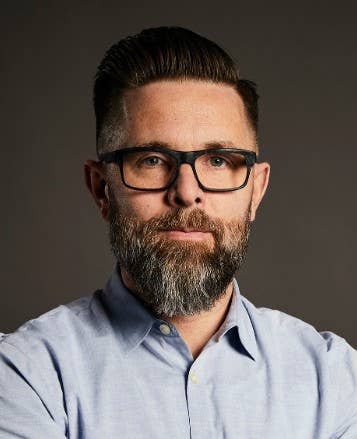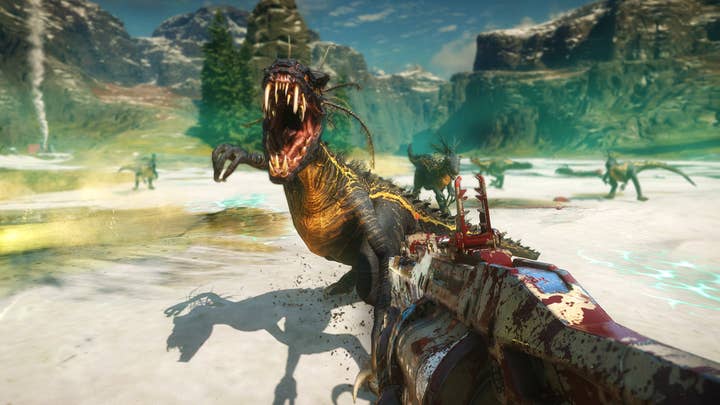Avalanche pushes in a new direction with Systemic Reaction
The Swedish firm's rebranded self-publishing division is aiming for faster development with smaller teams
If you tuned into the Xbox Series X livestream last week, you caught a glimpse of the latest game from the company behind Just Cause, Mad Max and Rage 2.
You'd be forgiven for missing the "Avalanche" name, though, because Second Extinction is being released under a different banner: Systemic Reaction, one of three distinct brands that comprise the new-look Avalanche Studios Group.
"The name 'Avalanche' comes with a lot of expectations," says Pim Holfve, CEO of Avalanche Studios Group, speaking to GamesIndustry.biz ahead of the Xbox reveal. "AAA, blowing shit up, that whole legacy... For our sanity as an organisation, and also for the three different target audiences that we had, we needed clarity."

The most familiar of those audiences is the one for its AAA, publisher-funded games -- the aforementioned Just Case, Mad Max, and Rage -- which will retain the Avalanche Studios brand. Then there's Expansive Worlds, which handles The Hunter: Call of the Wild, a quietly influential product that helped guide the Swedish firm towards self-publishing for the first time -- and without which, Nordisk Film's acquisition in 2018 may never have happened.
Systemic Reaction is the final piece, and a new name for the nascent self-publishing division that emerged with Generation Zero. Announced in 2018 and officially released last year, Generation Zero established a new template for Avalanche to try out new ideas; smaller teams, faster iteration, and developed alongside a live community of players. When we spoke to Holfve at the time, he described it as "30% of a AAA product."
"Generation Zero paved the way for something new, so we needed another direction," says Tobias Andersson, managing director of Systemic Reaction, the brand under which Generation Zero now sits. "We needed space to do other games that were neither outdoors games nor AAA games... All of a sudden we could expand in a direction that saw new opportunities, and wouldn't compete with or cannibalise the other games we have."
"The name 'Avalanche' comes with a lot of expectations -- AAA, blowing shit up, that whole legacy"
Pim Holfve
Second Extinction will be the second title bearing the Systemic Reaction name, and it shares distinct characteristics with other products across the Avalanche portfolio. As Emil Kraftling, the game's creative director explains: "It lies in player freedom, and in open, systems-driven worlds -- we hand ownership of the short-term and long-term narrative to the player, as opposed to guiding them down a path."
What sets it apart from the other divisions within Avalanche is how freely it can experiment with that basic structure. While Avalanche Studios is concerned with pitching to publishers, and Expansive Worlds is focused on a specific, self-published IP, Systemic Reaction will empower smaller teams to run with ideas that can be shaped in early access. Second Extinction has a team of around 30 people, roughly the same number that continues to work on Generation Zero.
"From experience, that team size makes for very nimble and quick communication, with a lot of ownership within every role," Andersson says. "Autonomy is extremely strong in those teams... It has been very beneficial for the products, and we definitely see a pattern that we want to rinse and repeat."

Generation Zero was announced just under two years ago, and only received an official launch in March 2019. According to Andersson, the fact that Systemic Reaction is already revealing its new project speaks to an early objective of "releasing a game a year"
"That was daunting," he admits, "but at the same time quite exciting. It was a statement to also push the whole company in a direction where we could release to market quicker, or at least experiment with that timing... How aggressive can we be?
"I don't think we've found the right temperature or the right measurement for that yet, but we started with a quite aggressive roadmap -- can we release a game a year?"
That objective was tied to an ideal structure for Systemic Reaction, which would see multiple teams of similar size working on individual projects in parallel. Second Extinction is a realisation of this idea, Andersson says, as the creation of its team has not resulted in fewer resources for Generation Zero. There are now two teams within Systemic Reaction, and that is likely to grow.
"We started with a quite aggressive roadmap -- can we release a game a year?"
Tobias Andersson
"Not being a behemoth, but being able to push out games if it makes sense," Andersson says, of the thinking behind the division's growth strategy. "We want a portfolio, and we think we have several ideas to go still."
In terms of the product itself, Second Extinction will speak to a slightly different kind of player to Generation Zero. Where that was an idiosyncratic, co-op survival game set in a dystopian 1980s Sweden, this will be more focused on action, with groups of players squaring off against packs of rampaging dinosaurs.
"A much more consistently fast-paced game," Kraftling says. "Quicker to get into, quicker on the immediate satisfaction -- a bells-and-whistles, explosions-in-your-face experience. It definitely has longevity to it, but the second-to-second interactions are much more intense."

Encouraging diversity within its portfolio helps Avalanche serve the market, Holfve adds, but it's also been valuable in making it a more satisfying place to work. This year was always intended to be one of growth for the company, and Systemic Reaction has added a dimension to what Avalanche can offer its employees that was little more than a pipedream five years ago.
"Back in the day we crossed our fingers and hoped we landed a new contract"
Pim Holfve
"Back in the day we needed to sell a AAA project to a publisher, and crossed our fingers and hoped we landed a new contract... Now, all of a sudden, we have something different to offer our employees. If you're working for three years on a AAA project, it might be good to use that knowledge and experience on something from Systemic Reaction instead -- and vice versa."
Of course, those plans to grow its workforce -- by around 100 people, according to Holfve -- hit a significant obstacle in the ongoing COVID-19 pandemic, and its various consequences for businesses all over the world. The first reaction when the reality of the issue became apparent was "panic," Holfve says, but he quickly set the goal of aiming for "business as usual."
"I think it took us two days to get up and running," Holfve says. "It was a confirmation that we could at least maintain our existing business."
"If someone asked me four months ago if we could do this transition, I would have said nope, that's not possible," Andersson adds. "But when it was a reality, I was baffled by how -- I won't say easy, because there was a lot of hard work from a lot of very energetic people to get this going -- but actually getting up and running with almost full capacity has [not been difficult] compared to what I expected.
"Overall, I would say we're doing very well. Our games are delivering on the milestones that they should, they're hitting the goals we set out before the crisis... So far, so good. If it lasts another six months, call me again."

